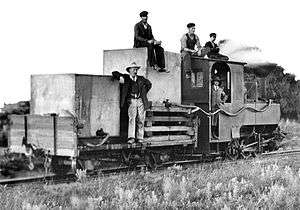CGR NG 0-6-0T
| CGR NG 0-6-0T South African NG 0-6-0T | |||||||||||||||||||||||||||||||
|---|---|---|---|---|---|---|---|---|---|---|---|---|---|---|---|---|---|---|---|---|---|---|---|---|---|---|---|---|---|---|---|
|
No. NG21 with a makeshift water tender | |||||||||||||||||||||||||||||||
| |||||||||||||||||||||||||||||||
| |||||||||||||||||||||||||||||||
| |||||||||||||||||||||||||||||||
| |||||||||||||||||||||||||||||||
The Cape Government Railways NG 0-6-0T of 1903 was a South African steam locomotive from the pre-Union era in the Cape of Good Hope.
In 1902, Arthur Koppel, acting as agent, imported a single 0-6-0 narrow gauge tank steam locomotive for a customer in Durban. It was then purchased by the Cape Government Railways and used as construction locomotive on the Avontuur branch from 1903. In 1912, this locomotive was assimilated into the South African Railways and in 1917 it was sent to German South West Africa during the First World War campaign in that territory.[1][2][3][4]
Manufacturer
A single locomotive, built by Krauss & Company in 1902, was imported in 1902 by Arthur Koppel, acting as agent. It was purchased by the Cape Government Railways (CGR) and placed in service from 1903 as construction locomotive on the narrow gauge Avontuur branch out of Port Elizabeth, where it was colloquially known as the Koppel engine.[2][3][4]
The locomotive was a Krauss type XXVIIab with works number 4830, which was unique in South Africa. It appears to be identical to half a Zwillinge, the twin Feldbahn locomotives built by the same firm and others for the Swakopmund-Windhuk Staatsbahn in German South West Africa, except that the cab was enclosed at the rear. The engine had outside Stephenson valve gear and was a coal burner, fitted with a balloon chimney to accommodate a spark arrester.[3][5][6]
Service
Cape Government Railways
The photograph shows the locomotive hauling a makeshift water tender, consisting of two water tanks on a two-axle goods wagon, with a water pipe strung along the locomotive's side to feed water into the side tanks on the engine. After completion of the Avontuur line, the locomotive was retained in service since it could haul three passenger coaches more economically than a petrol railcar.[2][3][4]
South African Railways
When the Union of South Africa was established on 31 May 1910, the three Colonial government railways (CGR, Natal Government Railways and Central South African Railways) were united under a single administration to control and administer the railways, ports and harbours of the Union. Although the South African Railways and Harbours came into existence in 1910, the actual classification and renumbering of all the rolling stock of the three constituent railways were only implemented with effect from 1 January 1912.[1][7]
When it came onto the roster of the South African Railways (SAR) in 1912, the locomotive was numbered NG21, with the letters NG identifying it as a narrow gauge locomotive in the SAR registers.[1][2][3][4]
First World War
In 1915, shortly after the outbreak of the First World War, the German South West Africa colony was occupied by the Union Defence Forces. Since a large part of the territory's railway infrastructure was destroyed or damaged by retreating German forces, an urgent need arose for locomotives for use on the narrow gauge lines in that territory. In 1917, no. NG21 was transferred to the Defence Department for service in South West Africa. It did not return to South Africa after the war and was withdrawn from service in 1918.[2][4][8]
References
| Wikimedia Commons has media related to CGR NG 0-6-0T. |
- 1 2 3 Classification of S.A.R. Engines with Renumbering Lists, issued by the Chief Mechanical Engineer's Office, Pretoria, January 1912, p. 47 (Reprinted in April 1987 by SATS Museum, R.3125-6/9/11-1000)
- 1 2 3 4 5 Paxton, Leith; Bourne, David (1985). Locomotives of the South African Railways (1st ed.). Cape Town: Struik. pp. 111–112, 157. ISBN 0869772112.
- 1 2 3 4 5 Espitalier, T.J.; Day, W.A.J. (1944). The Locomotive in South Africa - A Brief History of Railway Development. Chapter II - The Cape Government Railways (Continued). South African Railways and Harbours Magazine, April 1944. pp. 253-257.
- 1 2 3 4 5 Dulez, Jean A. (2012). Railways of Southern Africa 150 Years (Commemorating One Hundred and Fifty Years of Railways on the Sub-Continent – Complete Motive Power Classifications and Famous Trains – 1860–2011) (1st ed.). Garden View, Johannesburg, South Africa: Vidrail Productions. p. 232. ISBN 9 780620 512282.
- ↑ Schmeiser, Bernard (1977). Krauss-Lokomotiven. Verlag Josef Otto Slezak, Wien. ISBN 3-900134-36-7.
- ↑ Soul of A Railway - System 3: Cape Midland, based in Port Elizabeth – Part 1: The Port Elizabeth Narrow Gauge – Introduction - Caption 2 (Accessed on 10 December 2016)
- ↑ The South African Railways - Historical Survey. Editor George Hart, Publisher Bill Hart, Sponsored by Dorbyl Ltd., Published c. 1978, p. 25.
- ↑ Espitalier, T.J.; Day, W.A.J. (1947). The Locomotive in South Africa - A Brief History of Railway Development. Chapter VII - South African Railways (Continued). South African Railways and Harbours Magazine, December 1947. p. 1033.
